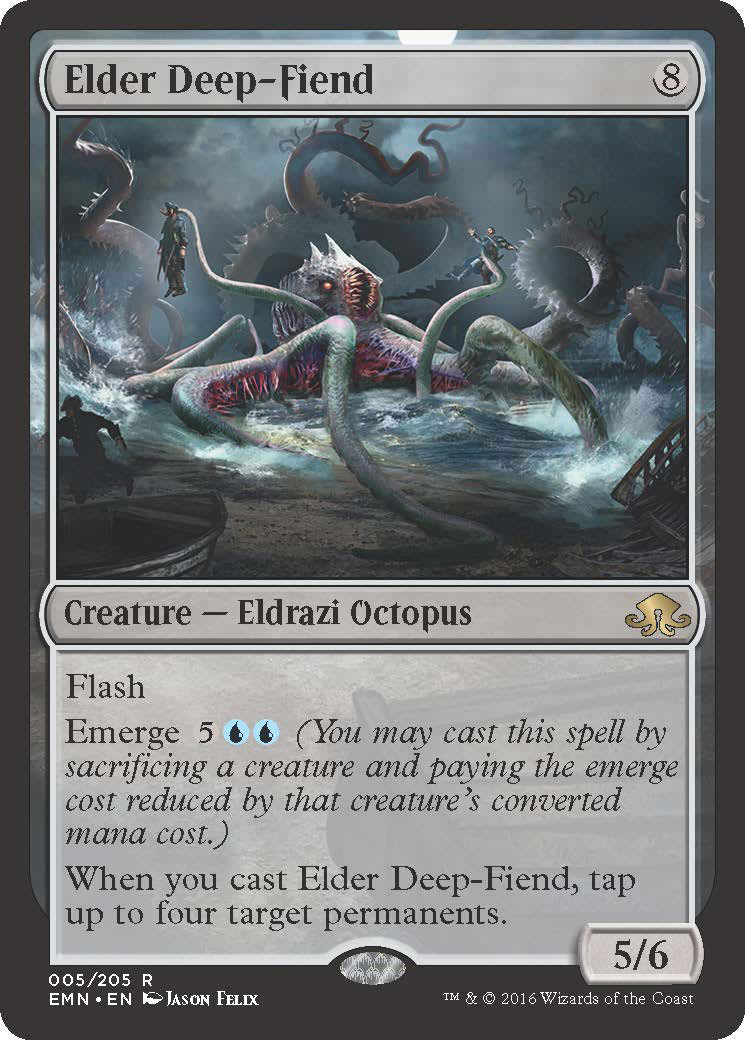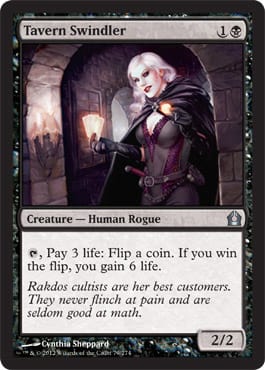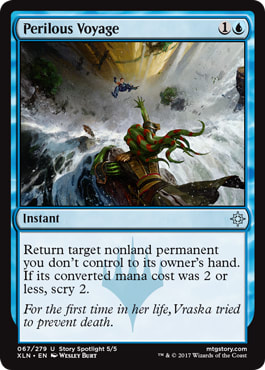 I'm trying to decide whether someone from Magic's creative team has read China Mieville's The Scar.
I'm trying to decide whether someone from Magic's creative team has read China Mieville's The Scar.
Or, well, that's not quite accurate. I'm pretty sure SOMEONE has just because WotC is staffed by a bunch of nerds and Mieville is a major contemporary speculative fiction author. It would actually be surprising to me if no one from the team had read the book.
I guess what I'm really wondering in particular is whether "High And Dry," a metropolis made of a huge concretion of ships all cobbled together and converted into a floating pirate city, is a direct homage to The Scar's "Armada," a metropolis made of a huge concretion of ships all cobbled together and converted into a floating pirate city. It could be an inspiration, albeit perhaps unconsciously . . . but it's also possibly just really freaking obvious.
Oh, the pirates on this world are so powerful that they have a faction all to themselves? Well, a pirate city seems obvious as a thing to add, but this is Fantasy, so we've gotta punch up the fantastic elements a bit . . . let's make the pirate port one big mass of ships! It does seem pretty straightforward as a worldbuilding choice, when put in those terms, and Magic (according to the Creative team in various interviews and panels) has lately focused a lot on taking fairly obvious aesthetic paths and trying to simply do them better than anyone else. It's a gutsy move and one that in recent years has certainly paid off.
What really intrigues me about the connection, though, is that it's another data point for me in this mental map I'm building between Magic the Gathering and the New Weird. Charting this out is giving me some trouble because I'm not entirely sure I've got a grip on what the New Weird is, precisely. My major inroad to it is via Mieville — a major author but still just one guy — and through its historical precursors and inspirations — the Old Weird of folks like William Hope Hodgeson and the always lurking Lovecraft, and some of the wild and strange science fiction and fantasy of the New Wave in the 70s.
The New Wave took a lot of Golden Age storytelling and applied a new, literary, psychological, soft-science, and often psychedelic filter to the material. My sense of the New Weird is that it does something similar, but more directly employs the tentacles of the Old Weird to reshape speculative fiction. New Weird carries on a tradition of fantasy worlds that are unabashedly strange, diverse, and somewhat difficult to systematize. Giant spiders or centaurs are passe; giant cannibal caterpillar men, immortal space bat capitalists, or anything covered in tons of eyes are more the order of the day. If you see giant spiders they're probably extradimensional, unfathomable beings interested in you primarily as an aesthetic object.
Magic is pretty darn weird on the whole. Oh sure we had a few years right at the beginning that were very medieval fantasy, but don't forget that Living Wall was in Alpha in all its fleshy glory. Phyrexia pretty quickly steered Magic down the path of New Weird, and of course Fallen Empires introduced the idea early in the game's history of selective biological magic used as an attempted hack to survive catastrophic climate change. By the time we got to Rath — an artificial plane populated by strange pillaged and mutated creatures with a massive engine at its center pumping out flowstone nanomachines in order to increase the plane's mass so that it would collide with and overlay onto a whole other reality — Magic was well and truly in the realms of the Weird.
I'm not going to try and litigate the full relationship between Magic and the New Weird today; that's way too big a topic for just this article. That very brief gloss of Magic's strangeness will have to do for now, maybe bounced off of Jeff VanderMeer's attempt to summarize the movement. What's interesting to me though is the way certain tropes in role playing and table top gaming intersect usefully with the kind of worlds that the New Weird tries to build. High and Dry is one such trope, if we recognize it in its other form:
The Tavern where the adventure starts.
The Tavern is infamous as the starting point of countless D&D campaigns, and it's got real good reasons for being so popular. The really great thing about The Tavern as a hook of course is that it's a place where you can throw a bunch of disparate people together all at once and it makes obvious intuitive sense. This is excellent from a New Weird perspective because it achieves the ends of 1. introducing all the odd diversity of the world which makes it so distinct from our own while 2. grounding it in something resembling daily life and the utilitarian, making it clear that as alien as the world might be, it's also to be understood as a real world where real people really need a damn drink.
The fantasy pub always sort of hovers between public and private in the sense that there's tons of people there, but they're often keeping to themselves, cloaked in their own secrets. (Cue jokes here about the non-euclidean geometries fantasy pubs need to have in order to accommodate all the different people all lurking in their own, private, dark corner.) It helps bridge the gap between the deeply unfamiliar and the recognizable — a core motif for fiction so interested with the edge of the known.
When you're telling stories on the scale of a whole world, a pub probably doesn't cut it, though. And so, you have something like the Armada in The Scar, or High and Dry in Magic. These settings and others like them (Mos Eisley, Bree, Waterdeep, Diagon Alley, Mercadia City, etc.) work as larger scale village sized pubs, geographical hubs where a whole bunch of different cultures meet. These hub locations are the logic of the pub on the scale of more global commerce and politics.
Magic's story sort of doubles up: not only do we have a whole location that serves as a pseduo-pub, but Jace and Vraska visit a pub within it where they have a fateful encounter with a River Guardian. The location is serving its purpose well there, bringing together different factions on neutral ground in order to enable information to pass from one group to another.
Magic doesn't just tell stories on the scale of worlds, though. It tells stories on the scale of universes. And so, we have Shandalar, Rath, Dominaria, and, perhaps above all, Ravnica. These worlds take the logic of the pub and expand it to the scope of a multiverse. It makes perfect sense that Tezzeret would set up shop with the Infinite Consortium on Ravnica — the city is already so vast and weird that Planeswalkers popping in and out hardly seems worth noting (unless you're an ancient dragon mastermind I guess). Ravnica is a wonderful setting for urban fantasy, but urban fantasy is always one step away, in my experience, from becoming weird fantasy, and in Ravnica we can see plenty of parallels to Mieville's central nightmare city of New Crobuzon — the diversity of the population, the stratification of society, the presence of advanced and deeply weird magic woven into society as a fundamental technological fact of life.
This is pretty distant from Ixalan, of course, but I think it's interesting that within Magic we have these locations that do the same narrative work at multiple different scales, to accommodate the way that Magic itself shifts between the personal, the environmental, and the trans-planar. This I think runs parallel to the way Magic's narrative shifts back and forth between a more straightforward pulp sensibility and more experimental storytelling. Jace and Vraska are quite overtly going on an adventure on this new world, and Huatli is explicitly a dinosaur knight on a quest. The characters may be somewhat strange, but the pulp structure of Ixalan seems pretty obvious
And yet, there's something in the way Jace and Vraska's narrative is so deeply about their respective traumas and their attempted recovery and reconstruction of themselves that makes me think of the New Wave and the New Weird's literary interests. The Scar, notably, plays extensively with its title: the Scar is both a region of the world where the coming of an alien, probability-warping civilization shattered reality, and also a symbol for injury, destruction, trauma, and recovery. These disparate strands are woven together through the vehicle of the floating city of Armada, which can both be the starting point of the epic quest for The Scar and a place where characters struggle to make a place for themselves.
So, this is sort of an ode to High and Dry and all such taverns in fantasy. High and Dry is an obvious choice for a setting like Ixalan, but it's not just because it's a cool adventure set piece. The Tavern isn't merely popular as a pulp cliche or a bit of supremely lazy Dungeon Mastering. It's a worldbuilding and narrative tool of use even in traditions like that of the New Weird, where the familiar and unfamiliar constantly brush tentacles.


























